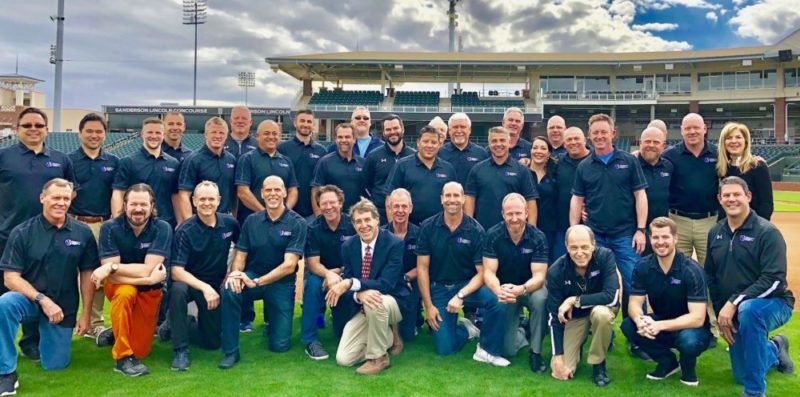The 4th annual Professional Baseball Chiropractic Society (PBCS) Seminar and Workshop took place on Jan. 19-20. It was held at the beautiful spring training home of the Kansas City Royals and Texas Rangers in Surprise, Ariz. This was the third consecutive year that the PBCS Seminar and Workshop was hosted at a Major League Baseball (MLB) spring training facility. Thirty-four team chiropractors were in attendance from the MLB and Minor League Baseball (MiLB), representing a total of 18 MLB organizations.
The lineup of presenters this year was top-notch. Craig Couillard, DC, team chiropractor of the St. Paul Saints and president of the Minnesota Chiropractic Association, spoke on the assessment and treatment of sport hernias and how it relates to the baseball player. Douglas Scott, ATC and senior vice president of Multi Radiance Medical, presented on the scientific and practical applications of laser therapy for baseball players. Ken Crenshaw, head athletic trainer of the Arizona Diamondbacks, talked about the keys to a successful and effective multidisciplinary practice approach. Patrick Hammond, DC, team chiropractor of the Kansas City Royals, discussed the different treatment protocols for different conditions and how to maintain a healthy ball club, which was followed by a breakout session on various adjusting techniques. It included Dr. Casey Hummel, president of Fascial Distortion Model. Each attendee was introduced to a hands-on introduction/demonstration to the practice of the Fascial Distortion Model in relation to the baseball athlete. Kansas City Royals athletic trainers Kyle Turner and Sean Bardenett presented next. They spoke on the hip and spine of the athlete, and how they relate to the baseball player.

Problems in Pro Baseball: Concussions and Performance-Enhancing Drugs
The keynote speaker of the weekend was Gary Green, MD. Dr. Green currently serves as medical director for Major League Baseball, as well as their research direct and consultant on anabolic steroids and performance-enhancing drugs. One of the topics that Dr. Green discussed was mild traumatic brain injury (MTBI) in baseball. Concussion has been a very hot topic in recent years, especially within collision sports such as football and hockey. Baseball is no stranger to this either, and it is an area of concern. Dr. Green discussed how rule changes were established to reduce the incidence of MTBI, especially in the catcher position. Since a rule was established in 2014 to eliminate collisions at home plate, the number of injuries and concussions since then has been dramatically reduced.
Concussion assessment in professional baseball is very strict. When a player is suspected of suffering from a concussion, an MLB concussion assessment form must be signed by the head ATC and team physician of the players club and submitted at the time of the injury. In order for a player to be cleared to return to play, the player must submit the following and be cleared by the MLB medical director:
- A return to play form;
- Submit imPACT and any supporting data;
- All symptoms have resolved; and
- Physically examined and cleared by the team physician.
The complete elimination of concussions in professional baseball is probably unrealistic, but MLB has taken some major steps forward in preventing and treatment them.
Probably the most talked about controversy involving professional baseball in recent years is the use of performance-enhancing drugs (PEDs). Dr. Green served as a member of the National Collegiate Athletic Association’s (NCAA) Committee on Competitive Safeguards and Medical Aspects of Sport and chaired the NCAA Committee on Drug Testing and Drug Education for five years. To say that he’s an expert in the field would be an understatement. Dr. Green stated that MLB has made many changes to its drug programs, such as:
- Increased testing;
- Tougher penalties; and
- A shift in player perspective. Simply put, MLB players are tired of cheating and want a clean game.
With regard to supplements, contamination is still a problem. In a study of 64 nutritional supplements, 12.5% contained banned substances not declared on the label. This is where NSF’s Certified for Sport program comes into play. The program’s objective is to certify that participating sports supplement manufacturers have met NSF’s stringent independent certification process guidelines. In 2010, 50 products were NSF-certified. That number has risen to more than 700 products today. We are seeing a growing trend of awareness and education to eliminate PEDs from baseball and keep the game clean while maintaining its integrity.
The Current and Future State of Chiropractic Services in Pro Baseball
The current state of chiropractic within professional baseball is growing. Today, 28 of the 30 teams in MLB utilize a chiropractic consultant. And we are seeing the affiliates in MiLB expand with utilization of chiropractic care, too. As of December 2017, over 40 MiLB teams were utilizing a chiropractor and this number is climbing. The PBCS has been working with the Professional Baseball Athletic Trainers Society (PBATS) to help place qualified chiropractors with teams in MiLB. We envision every team in professional baseball recognizing chiropractic as an official component of their sports medicine team, and we will continue to work diligently until this goal is achieved.
Dr. Bishop is director of the Professional Baseball Chiropractic Society. For more information, visit probaseballchiros.com or email [email protected].
PHOTO: The PBCS team chiropractors on the field of Surprise Stadium, spring training home of the Kansas City Royals and Texas Rangers in Surprise, Ariz.
